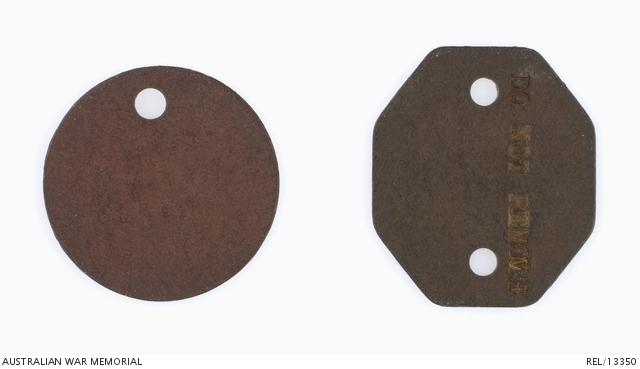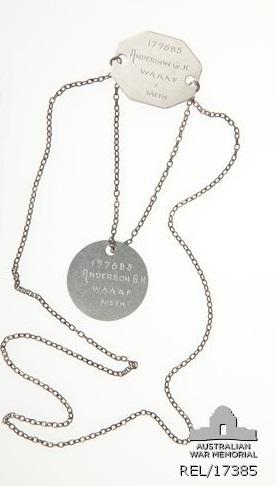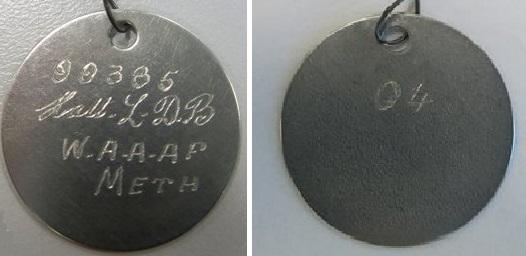Understanding Australian Identity discs part 4: Second World War, Royal Australian Air Force
Unlike for the Navy and Second AIF, I have not been able to locate copies of orders regarding the issuing, marking and wearing of identity discs for members of the Royal Australian Air Force (RAAF) during the Second World War. The information below was compiled from the inspection of identity discs in the Memorial’s collection and information on comparable items found in publications and online.
Wearing of identity discs
The Royal Australian Air Force (RAAF) came into existence in 1921. During the First World War, airmen that served with the Australian Flying Corps (AFC) were part of the Australian Imperial Force, so they followed the AIF orders for the issuing and wearing of identity discs. The lessons of the First World War led the RAAF to continue issuing two identity discs – the octagonal No. 1 disc (to remain with the body) and the circular No. 2 disc (to be used to record the death of the service person). Interestingly, the RAAF did not continue with the compressed fibre discs of the First World War like the army did, but issued metal discs made of either stainless steel or aluminium.
You don't always see RAAF personnel in photographs wearing their identity discs, even in instances where they would not be hidden by their uniform. While the discs would have had most importance when flying on operations, they were perhaps not regarded as being as necessary when on base. For ground crew or workshop personnel, there are also practical reasons not to wear an identity disc around your neck especially when working with machinery where the discs’ cord could get hooked or be in the way.
MARKING
While some discs are stamped with the service person’s details, like the army continued to do, most of the RAAF discs held in the Memorial’s collections are engraved. In other circumstances engraving on discs often indicated they were unofficial discs, but this does not appear to be the case with the RAAF.
Markings on the discs tend to follow the format below:
Front side:
SERVICE NUMBER
SURNAME and INITIALS
RAAF
RELIGION (abbreviation)
- B - Baptist
- C - Congregational
- CC - Church of Christ
- CE or CofE- Church of England
- CS - Christian Scientist
- GO - Greek Orthodox
- J - Jewish
- L - Lutheran
- M or METH - Methodist
- P, PRES or PRS - Presbyterian
- RC – Roman Catholic
- SA – Salvation Army
Reverse:
Blood Type
BLOOD TYPES
With the introduction of blood transfusions, blood type was usually recorded on the reverse of the identity disc but you do sometimes find it on the front with the other details. The letter and number stamped on the back of identity discs are the combination of two different blood identifications schemes, the Moss System and Landsteiner’s original scheme (International System). The Moss System was a classification of blood groups that labelled blood groups 1 through 4 and the International Scheme used letters we are familiar with today (O, A, AB etc). Using both systems on the discs could speed up transfusions and avoid any adverse reactions. Further information about blood transfusions and the use of the two systems can be found in Chapter 34 of Australia in the War of 1939-1945: Series 5 - Medical, Volume I - Clinical Problems of War.
IMPROVISED DISCS
Improvised discs tend to be rarer in the Second World War. However, you sometimes find privately sourced identity discs replacing lost issued ones or identity bracelets used to supplement the discs worn about the neck.
AUSTRALIANS SERVING IN THE ROYAL AIR FORCE AND TRAINING IN CANADA
The Canadian, British and New Zealand air forces continued to use compressed fibre identity discs in the Second World War. During the war a large number of Australians trained in Canada as part of the Empire Air Training scheme. Australians also enlisted in or were seconded to the Royal Air Force (RAF). All the discs held at the Memorial for Australian RAAF members serving in the RAF are metal and were likely issued early in their service, but it is probable that fibre discs exist that were issued as replacement discs to Australians in the RAF. Certainly compressed fibre examples exist that were issued to Australians while training in Canada. The markings on these discs are in the same format as those issued to members of the Royal Canadian Air Force (RCAF), not in the format used by the RAAF.
Front side:
NATIONALITY (abbreviated) and SERVICE NUMBER
AIRMAN or OFFICER
INITIALS and SURNAME
RELIGION (abbreviated) and RAAF
Reverse:
The green No. 1 disc has “DO NOT REMOVE” impressed on the reverse.
Interestingly, Blood type appears to be rarely included on the reverse.

Reverse of Canadian identity discs issued to an Australian.
REL/13350
THE WAAAF
The Women's Auxiliary Australian Air Force (WAAAF) was established in 1941 and members were also issued with metal identity discs.








